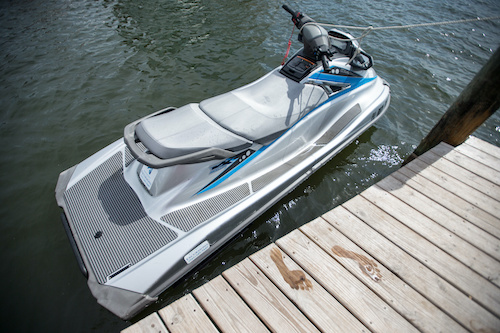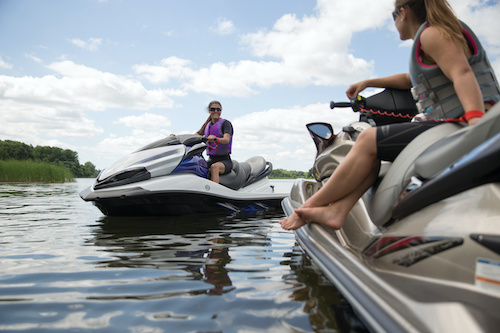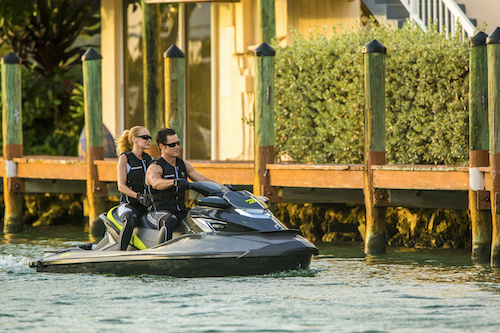Even if you keep your personal watercraft (PWC) on a trailer, your day on the water aboard a Sea-Doo, WaveRunner or Jet Ski is likely to begin and end at a dock, and may include tying up at a gas dock, restaurant, or other dock.
Knowing how to successfully approach a dock will make you look like a pro and help avoid damage to your PWC, and injury to you and your passenger. Here’s how to dock a PWC the right way...
7 Steps for Docking a PWC, Jet Ski, WaveRunner or Sea-Doo
- Study the situation—approach into the wind or current, if possible.
- Be aware of other nearby boat traffic.
- Think about where you'll tie up to secure your dock line.
- Tell any passengers to sit tight and have dock lines ready.
- Approach the dock slowly—come in at idle.
- Use short blips of throttle to help with steering control.
- If applicable to your craft, use attached cleats, or loop the line around the base of your handlebars.
Explore All Personal Watercraft (PWC) Brands & Models
Because a PWC does not have a rudder, and relies on thrust from the jet pump to steer, its course is quickly influenced by momentum, wind and current as soon as you let off the throttle. Ideally, you’ll want to approach into wind or current if possible, as you’ll have more control.
At a public dock, study the flow of boat traffic, look for other boats that may be coming into or pulling out of the dock, and consider where you’ll tie up. You’ll want to land at a spot on the dock near a cleat, for example, to secure your dock line.
If you have an inexperienced passenger aboard, instruct them to sit tight and to not reach out with a leg or arm to try and arrest the momentum of the PWC, which could lead to injury. If possible, have your dock lines ready before approaching the dock. If you have a passenger let them hold the lines.
Approaching a dock with too much speed always leads to trouble—you could bang hard into the dock, or need to use a lot of reverse thrust to arrest your speed, which can make it hard to control the PWC. You want to come in at idle, and use short blips of throttle if you need some steering control. Have an escape route in mind if you need to abort the approach, such as circling hard to the left or right and heading away from the dock so you can re-group and start over.
Docking with No Wind
If there’s little or no wind or current, take the following steps:
- Approach the dock at a 20-degree angle.
- When you are about two PWC lengths away from the dock, steer away from the dock and give the throttle a blip to push the stern around towards the dock.
- Then if necessary, shift to reverse and use a quick blip of throttle to slow your forward momentum.
- With practice you’ll be able to stop right next to the dock.
Use this same technique if you are heading into wind blowing (or current flowing) along the length of the dock.
Wind Off the Dock
If the wind is blow off the dock, take the following approach:
- Increase the angle of approach to about 35 to 45 degrees.
- In this situation, you’ll need a little more power to approach the dock.
- When you are about a half-boat length from the dock, turn sharply away from the dock and apply a blip of power to bring the stern of the craft around until you are parallel with the dock.
- Be ready to toss a line to someone on the dock, or to grab a cleat on the dock, to keep the craft from drifting away.
Wind from the Stern
If the wind or current is coming from behind you, you should:
- Approach the dock at a more-shallow angle, about 10 to 15 degrees.
- Shift intermittently to neutral or reverse to slow your speed as required.
- When you are about two lengths away from the dock, steer away from the dock, then shift into reverse and steer towards the dock.
- This will kick the stern towards the dock, with reverse thrust holding it in place.
Wind to the Dock
If wind or current is moving perpendicular toward the dock, be sure to:
- Approach at a shallow angle, but make your turn within four of five craft lengths from the dock.
- Then allow the current or wind to push you toward the dock.
- Shift to neutral if possible and but keep the engine running so you’ve got power if you need to adjust your angle.
Docking a PWC with No Reverse
Many older PWC models, and some newer examples, do not have reverse thrust. In this case you’ll need to be very aware of your speed as you approach the dock.
- If possible, get aligned with the dock and then cut the engine.
- Let your momentum carry you the rest of the way. This takes some practice and keen awareness of wind and current.
- Another technique is to approach at a 40 degree angle, and then make a sharp turn towards where you want to land at the dock.
- This will slow your momentum. Then kill the engine and the craft will continue to drift around and, ideally drift up to the dock.
- If the wind or current is moving toward the dock, you can always cut power early and slowly drift up to the dock.
Tying Up a PWC
An advantage of docking into the wind or current is that either will push the craft away from rubbing against the dock after you’ve secured lines. Some PWC have a small cleat amidships, or an eye on the console, intended to secure a dock line. Many have neither, and in that case it’s OK to loop the line around the base of the handlebars.
With just one dock line your craft may swing out away from the dock. You can secure the craft against the dock by attaching a second line to the ski eye or the U bolt on the transom.
Read Next: How to Drive a Personal Watercraft (PWC)
You May Also Like:


